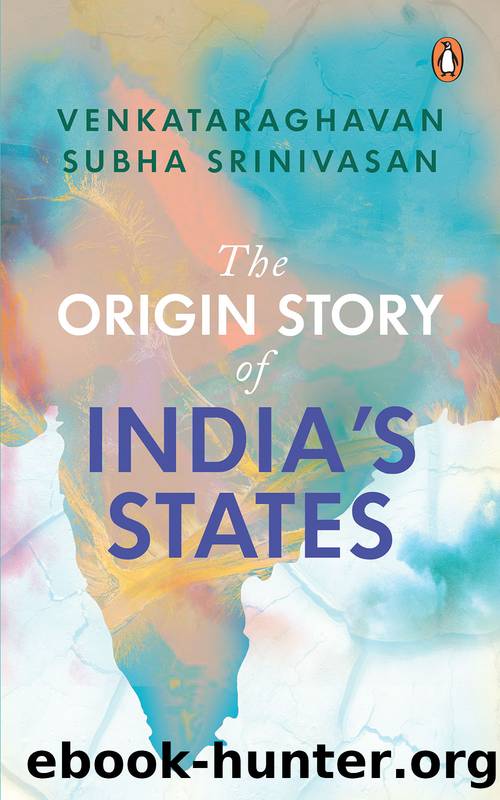The Origin Story of India's States by Venkataraghavan Subha Srinivasan

Author:Venkataraghavan Subha Srinivasan [Srinivasan, Venkataraghavan Subha]
Language: eng
Format: epub
ISBN: 9789354923166
Publisher: Penguin Random House India Private Limited
Published: 2021-10-12T00:00:00+00:00
1949â56: The Second Movement
In October 1949, as a countermeasure to the Punjabi Suba demand put forth by the SAD, the majority INC in East Punjab presented what became known as the Sachar Formula (or the SacharâGiani Formula). This was named after Bhim Sen Sachar, the East Punjab Premier, and Giani Kartar Singh, a SAD leader and a minister in the Sachar government. The Sachar Formula âdevised by two Hindus and two Sikhsâ12 sought to retain the bilingual character of East Punjab by dividing the province into Punjabi and Hindi zones where the dominant language would be the medium of instruction and the other language would be a compulsory subject. However, âby accident or designâ13, it sharpened the divide in the province along linguistic and communal lines.
The Sachar Formula generated heated controversy. Bhim Sen Sachar lost his premiership. The SAD capitalized on the formula recommendations by demanding autonomous status for the Punjabi-speaking region, presenting it as a linguistic demand. The discord between the two communities reached such a fever pitch that Prime Minister Jawaharlal Nehru directed that no language be recorded in the 1951 census in Punjab State (renamed from East Punjab after India adopted its Constitution on 26 January 1950). Hence, the 1951 census showed âHindi/Punjabiâ as a joint option.14
In the 1952 legislative assembly elections, the INC romped home with a huge majority in Punjab. In PEPSU, however, no party gained a clear majority. Even though the INC was the single largest party, the SAD built a coalition called the United Democratic Front (UDF) with other parties and formed a non-Congress government in PEPSU in April 1952.
Between October and December 1952, SAD leaders Hukam Singh and Master Tara Singh proposed the creation of a Punjabi Suba by merging the Punjabi-speaking region of Punjab State with PEPSU. This would create a Punjabi- and Sikh-majority state. This proposal was bolstered both by the imposition of Presidentâs rule in PEPSU in March 1953 and by the creation of Andhra State on a linguistic basis in October 1953.
Meanwhile, on 21 September 1953, the capital of Punjab officially moved from Shimla to Chandigarh.15
Towards the end of 1953, spurred by the multiple calls for state reorganization across the country, the Union government announced the creation of the States Reorganisation Commission (SRC) which invited memoranda from the public, individually and collectively. By May 1954, the SAD, the Congress, the Arya Samaj and the Jana Sangh had submitted separate memoranda for the reorganization of Punjab. The SAD reiterated its demand for Punjabi Suba, merging the Punjabi-speaking region with PEPSU and excluding much of the south-eastern region of Punjab known as Haryana. It built a linguistic argument that Punjabi was a distinct language recognized in the Indian Constitution with its own Gurmukhi script that was not derived from the Hindi Devanagari script.16
On the other hand, the State Congress proposed Maha Punjab by integrating Punjab, PEPSU and Himachal Pradesh. The Arya Samaj and Jana Sangh went a step further by including Delhi as well in the proposed amalgamation.17
In October 1955, the SRC released its report.
Download
This site does not store any files on its server. We only index and link to content provided by other sites. Please contact the content providers to delete copyright contents if any and email us, we'll remove relevant links or contents immediately.
| Historic | Information Systems |
| Regional |
Man-made Catastrophes and Risk Information Concealment by Dmitry Chernov & Didier Sornette(5958)
The Revenge of Geography: What the Map Tells Us About Coming Conflicts and the Battle Against Fate by Kaplan Robert D(4052)
Zero Waste Home by Bea Johnson(3808)
COSMOS by Carl Sagan(3592)
Good by S. Walden(3523)
In a Sunburned Country by Bill Bryson(3509)
The Fate of Rome: Climate, Disease, and the End of an Empire (The Princeton History of the Ancient World) by Kyle Harper(3035)
A Wilder Time by William E. Glassley(2837)
Camino Island by John Grisham(2779)
Organic Mushroom Farming and Mycoremediation by Tradd Cotter(2662)
The Ogre by Doug Scott(2659)
Human Dynamics Research in Smart and Connected Communities by Shih-Lung Shaw & Daniel Sui(2479)
Energy Myths and Realities by Vaclav Smil(2464)
The Traveler's Gift by Andy Andrews(2438)
9781803241661-PYTHON FOR ARCGIS PRO by Unknown(2343)
Inside the Middle East by Avi Melamed(2331)
Birds of New Guinea by Pratt Thane K.; Beehler Bruce M.; Anderton John C(2238)
A History of Warfare by John Keegan(2216)
And the Band Played On by Randy Shilts(2169)
